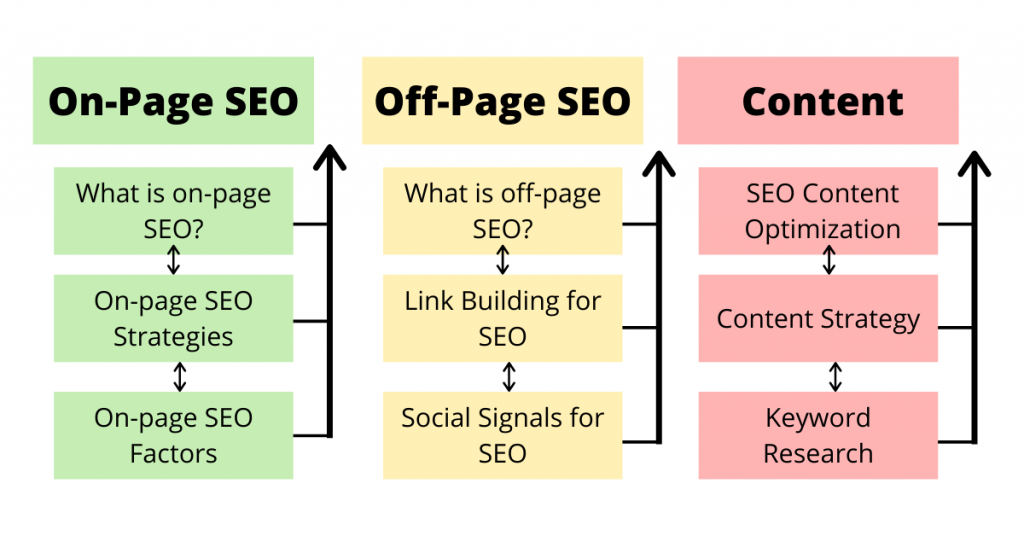SEO Silo Structure: How To Create One
When building a new blog, or any kind of money website for that matter, you want to maximize your resources to rank higher. Link building, on-page optimization, and content creation are all good, but they can be quite pricey sometimes. Many see content writing as the most expensive strategy in SEO. For this reason, we want to showcase how you can use a silo structure to make the most out of your SEO efforts.
Building a robust site architecture is, without a doubt, a great way of communicating relevance to Google. Even if your website doesn’t have a lot of link authority, it can still outrank competitors if it has some good on-page work and powerful architecture.
We talked a lot about content and external links in the past, but we’re not going to address them much in this article. This article will only focus on on-page SEO and silos for ranking. It is certainly possible to get advantageous positions like this. Kyle Roof is an SEO expert that ranked #1 for ‘Rhinoplasty Plano’ using an EMD (exact match domain) and mostly Lorem Ipsum text, without any links but with proper optimization.
Taking a bit of inspiration from him, we’re going to show you how to improve your SEO by building a silo structure, in this article.
What is an SEO Silo Structure?
Every website needs some sort of structure. Crawlers can’t read your content, nor make connections between your articles like a regular human. They can only read and interpret signals. Structuring your pages in a silo format through links or directories will allow the Google spiders to understand your blog easier.
Depending on the type of website you run, you may or may not map out this structure in advance. Bloggers naturally create a lot of content without thinking of a particular structure. This is normal, and a silo architecture can be implemented down the line without much of an issue. On the other hand, practical sites might want to create a structure beforehand.
Keep in mind, the more pages your website has, the harder it’s going to get to implement a good architecture. At 50 pages it’s not going to be a problem, but at 500+ you might stumble upon some issues. There are two types of silo structures.
Physical Silo
A physical silo is an architecture where pages are structured through directories or categories. The appurtenance to a specific directory needs to be communicated through the URL. If your pages are only accessible through the directory, it’s not going to be enough.

WordPress has a weird link structure by default. It includes all sort of useless things like the date, hour, year and number of the post, which communicate nothing of value to Google. The cleanest structure is “URL/post-name“, but you’d need to build a virtual silo for this.
To use a physical silo, you need to structure your links like this: https://www.example.com/category/post-name. This clearly shows the post name or product name and its appurtenance to a certain category. You can also have something like “/category/sub-category/” if your website is deeper.
By implementing this kind of physical silo in the URL structure of your website, your architecture can be clearly picked up by the crawlers. For every significant theme/subject you cover, you need a category. Each page related to that theme goes under that category, and no page will be part of two distinct categories.
This strategy is very beneficial for e-commerce/retail sites. For bloggers, a virtual silo is a better choice.
Virtual Silo
To create a virtual silo structure for SEO, you need to have an excellent internal linking strategy for your content. When coming up with a virtual silo, you want to separate your pages into a few clusters based on relevance. This way, Google will understand that all interlinked pages are related whilst the others are excluded, covering a different topic.
Google is following links from one page to another to determine the SERPs. Domain or page authority is important, but topic relevance might be even more essential. Virtual siloing is very popular since it reinforces your authority by creating a website hierarchy through cross-linking.

Let’s say you have an SEO blog. You create three main categories, on-page, off-page and content. Every blog article related to one of those categories would be placed in that silo. You can’t link from one silo to another. Your articles regarding on-page SEO would be interlinked between them, with no links to pages from other silos. All pages from a silo would also link to the main silo page.
Random linking between pages and other silos should be avoided. Even when cross-linking between pages of a silo, you should consider relevance first. Don’t just interlink all pages for the sake of linking. Try to link the subpages between them only where it makes sense while ensuring that all of them link up to the main article.
Do Silos Help with SEO?
It’s without a doubt that a silo structure is going to benefit your SEO greatly; otherwise, we wouldn’t write this in-depth guide. They have both seen and unseen benefits that can put you ahead of your competition easily.
Google Indexing
Search engines like Google index pages by following links from one page to another. Whenever a page is re-indexed, Google updates its database. This is how the Search Engine Results Pages are created too. But, this system also means that if you don’t have a solid structure, it will be harder for Google to understand your pages and their topic.
If you’re just randomly interlinking from one page to another just for the sake of it, you might create more harm than good. You don’t want to have orphan pages, but you also want to avoid cross-linking two pages that have completely different topics. If you’re writing an article about Link Building, but you’re linking to a Facebook ads article from your blog, you will only get the crawler confused as the connection is not clear.
However, when you have content structured in a silo format, this can help search engines understand and index your site better. If you create a silo that only has content about Link Building, Google will understand that you have topical authority. The bigger and more valuable that silo is, the more topical authority you will gain in the eyes of the algorithm.
This is essential as Google is putting more and more emphasis on topical authority, rather than just content and backlinks. Who do you think will rank higher, a general website with one article about Link Building, or an SEO site with a whole silo focused on Link Building?
Thrillist.com has a lot of website authority with a Domain Rating of 88. But that’s travel topical authority and can’t stand a chance in the SEO niche even against way smaller blogs.
User Experience
Having a solid user experience and great engagement metrics is one of the top ways of boosting your website in the rankings. Your bounce rate, number of page views per visitor and the time spent on the site are key signals Google is using for the SERPs. These metrics differ from one niche to another, but it’s obvious that the better they are, the more traffic you will get.
If someone arrives on your site through an article about link building, it’s pretty certain that they’re interested in that topic. If you can recommend them more articles covering the same topic, chances are pretty high that they will spend more time on the site. On the other hand, if they are reading about link building and you’re recommending articles about travel, they are less likely to spend time on the site, and more likely to bounce.
If people spend a lot of time on your site, the chances are that your content is helping them in one way or another. And, Google is only interested in providing more value to users. That being said, a great site structure can improve your engagement metrics, therefore boosting your rankings by a landslide.
Straightforward Internal-Linking
This is a more indirect benefit of having a great structure, but it’s going to save you a lot of time, especially if you’re planning to create a website with hundreds of pages. If you’re building your website chaotically and without a defined structure, the chances are that you forget some essential things every now and then.
If you do the internal-linking as you go, you’re going to have some orphan pages. Orphan pages don’t have any incoming links from anywhere on the web, and can’t be indexed by Google. No Google indexing means no rankings and a lot of wasted effort. But, if you do have a structure planned ahead of time, it’s a lot easier to keep track of all pages and make sure that you don’t have any orphans. This will save you time and ensure your indexing.
SEO Silo Structure Strategies
Now that we covered the basics of siloing, it’s time to lay down a few strategies that will give you more clarity and make your life a lot easier. If you don’t have a strategy, chances are pretty high that you might get overwhelmed and end up giving up on your SEO project. Let’s see what the best practices are.
Silo Keyword Research
Each silo structure needs to have a main page that you’d like to rank for. This is probably a cornerstone topic from your niche that has a lot of traffic. You need some keyword research to determine your main article topic. Don’t hesitate to go after a bigger main keyword that has greater difficulty. Even if you don’t get that high-traffic keyword, you’re still going to win a lot of other sub-topics, getting you enough traffic.

For the child articles within your silo, you should go for keywords that have a lower competition. These will provide you with a few small wins that will kickstart your silo. Go after question queries that have a keyword difficulty below 5. It’s going to be pretty easy to rank for these.
You should think of your silo as a conglomerate. The more links and traffic your silo gets, the stronger it becomes, regardless if the main source is the child posts or not. Thus, these smaller queries will boost your silo and increase your chances of ranking high for the main keyword.
URL Structure
To maximize your chances, you should opt-in for a URL structure that’s as simple as possible. You should use something like /example.com/article-keyword/ – this is all you need. No need for category tags in the URL as you can use a virtual silo. It’s very important to include your article keyword in the URL too, rather than the full title of the article.
Content Planning
There are a lot of things that you can plan ahead of time when building a silo structure for SEO. You’ll want to first figure out your main silo page for clarity purposes. You can plan your child posts in a manner that supports your cornerstone one.
Find a few easy-to-win topics through keyword research. Come up with titles/content topics for each of them. This will remove any writer’s block that you might experience as you’ll always know what you need to write next. Also, the first link of each article should always lead to the main page of that silo. This will give more juice to your main article as the order of links in post matters.
Conclusion
A silo structure is a great way of building a solid website architecture while improving your website SEO. Whilst most bloggers just publish articles and do internal linking sporadically; you can outrank them easily by planning ahead of time. If you implement the tips laid above, your website will surely have a solid structure.
Informative article on Silo for SEO, thank you.